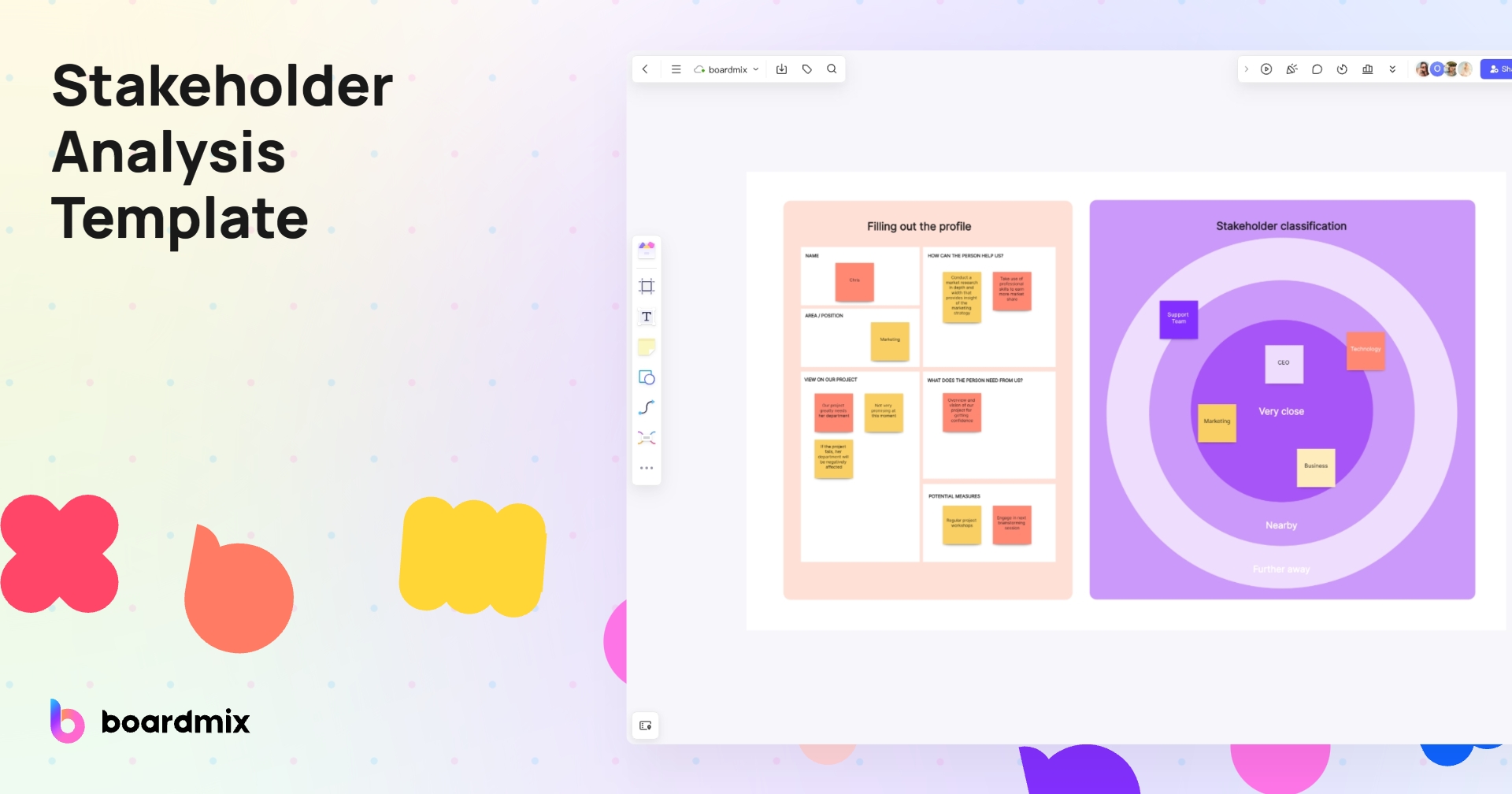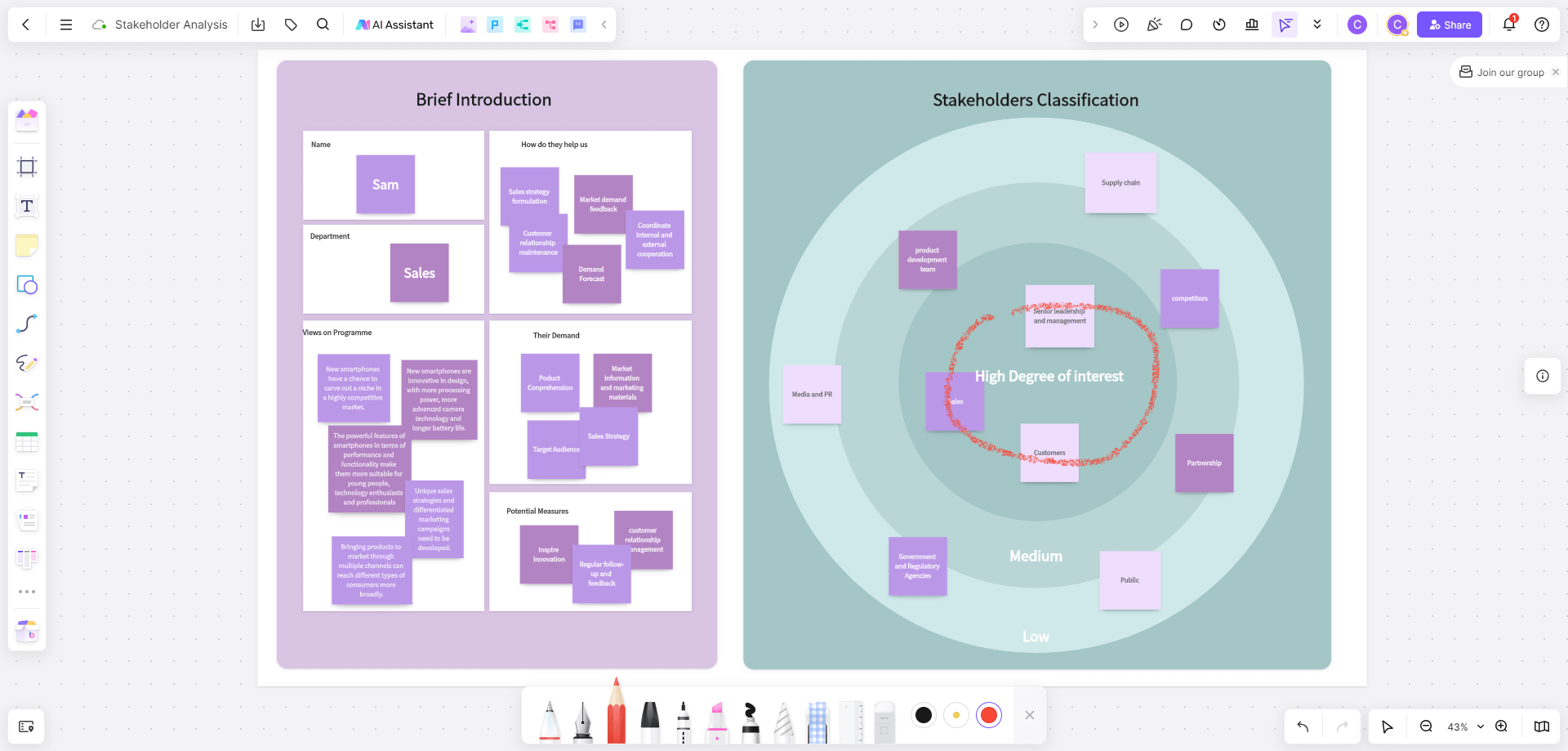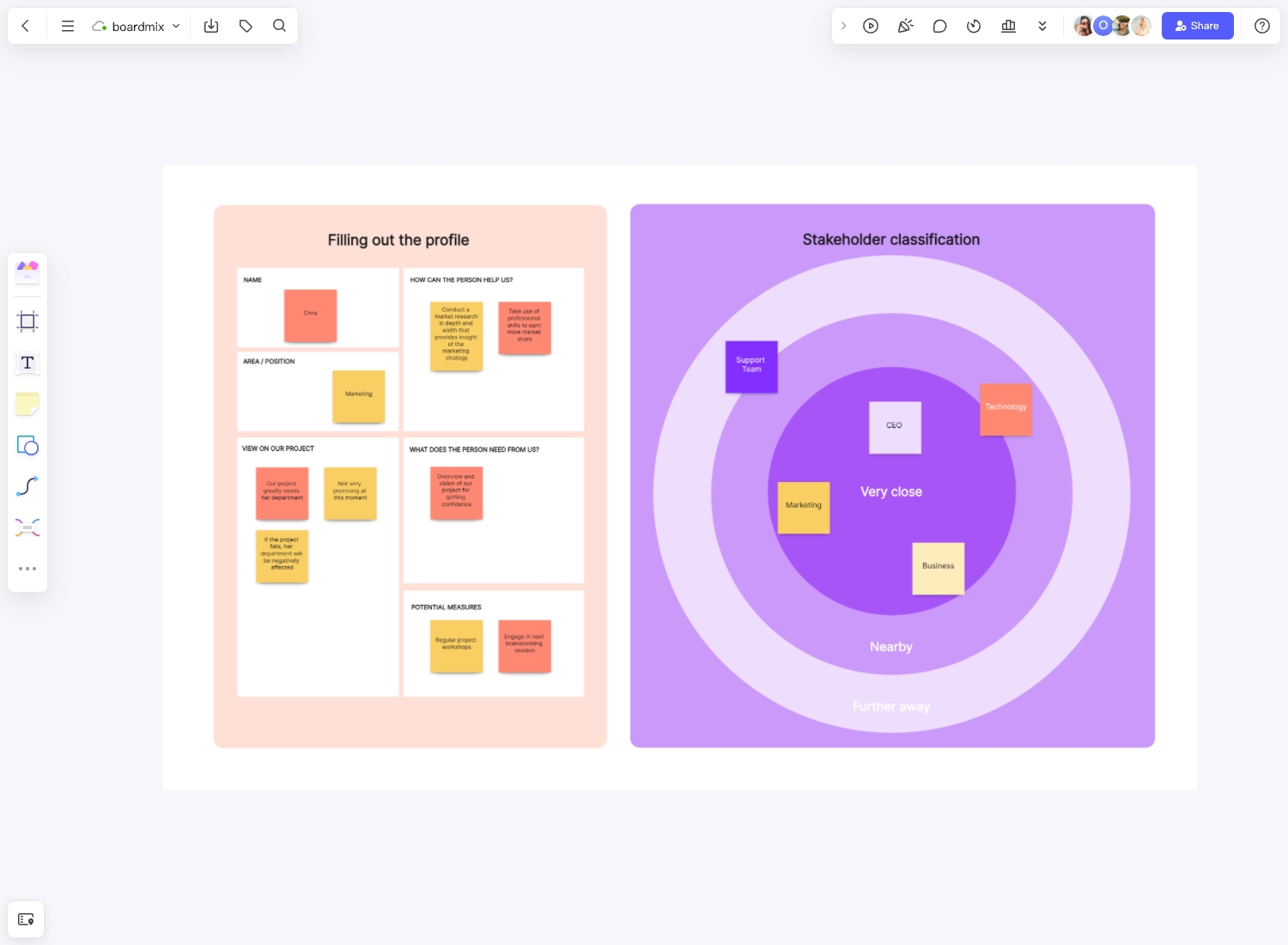About the Stakeholder Analysis Template
Explanation of Stakeholder Analysis
All businesses have at least a few stakeholders. In the business realm, numerous individuals and organizations can benefit from or express interest in your operations, directly or indirectly.

Build Stakeholder Analysis for Free
Understanding their diverse perspectives and motivations is vital due to varying levels of involvement, emphasizing the importance of comprehensive stakeholder comprehension. Some might invariably support your projects, while others might even go against them if it does not tie up with their needs. Because of this, it is necessary to conduct stakeholder analysis so that you can channel your efforts and resources accordingly.
Importance of Stakeholder Analysis
Since there are usually several stakeholders, it's not unlikely that each would have their own opinions and expectations about the project or the company. For your benefit, it is essential to perform an analysis of these varying perceptions. This will enable you to create feasible strategies for addressing each stakeholder's needs while continuing to strive towards the primary goals of your organization.
Purpose of the Article
This article is meant to help you create a viable stakeholder analysis template that you can repeatedly use for the various undertakings of your organization. It also highlights the benefits of having a stakeholder analysis template that will enable you to easily identify, prioritize and manage your stakeholders, ultimately saving much time and boosting productivity.
The Different Types of Stakeholders
Stakeholders can either be internal or external. In creating a stakeholder analysis template, you have to remember that each of these types has distinct needs and expectations from the business or company.

Internal Stakeholders
Internal stakeholders are people that are part of the organization. This includes the owner of the company, the board of directors, managers, employees, and investors. The performance of the business has a direct impact on these stakeholders because they benefit from the company’s growth and success. Similarly, they will also suffer if the company undergoes a setback.
Internal stakeholders also have different specific interests. Owners and investors are actually focused on maximizing revenue because this will benefit them directly. Employees, on the other hand, are more interested in their health and safety in the workplace, and whatever benefits they get from their job.
|
Name |
Role/Department |
Contact Information |
Stake in the Project |
|
John Doe |
Developer |
Code Implementation |
|
|
Jane Smith |
Sales |
Revenue Generation |
External Stakeholders
External stakeholders, on the other hand, are those who are not connected to the organization outside of their interest in the company's wellbeing. These include the customers, the suppliers, the regulatory bodies, and the communities to which the organization belongs.
Customers expect quality products and services from the business, while suppliers hope for higher demand. The regulatory bodies expect compliance with regulations, and the communities are likely expecting employment opportunities and a reliable supply of quality goods and services.
External Stakeholders
|
Name |
Organization |
Contact Information |
Stake in the Project |
|
Bob Anderson |
Supplier |
Supply of Materials |
|
|
Alice Johnson |
Client |
Project Delivery |
How to Use BoardMix's Stakeholder Analysis Template
To begin with, it's crucial to understand that BoardMix's Stakeholder Analysis Template is not just a tool, but a strategic ally in your business operations. It offers you the ability to identify key stakeholders, understand their interests, and determine how their involvement will impact your project or business decision.
1. Access the template: Log in to your Boardmix account and navigate to the templates section. Look for the stakeholder analysis template and click on it to open it.

2. Customize the template: Once the template is open, you can customize it according to your specific needs. Add or remove sections, modify headings, and include relevant information about your stakeholders.

3. Identify stakeholders: Start by identifying all the relevant stakeholders for your project or organization. This can include individuals, groups, or organizations that have an interest or influence in your work.
4. Assess stakeholder power and interest: Evaluate the power and interest of each stakeholder in your project. Power refers to their ability to impact your work, while interest refers to their level of concern or involvement.

5. Map stakeholders: Use the template to visually map out the stakeholders based on their power and interest. This will help you identify key stakeholders and prioritize your engagement strategies.
6. Analyze stakeholder perspectives: Consider the perspectives, goals, and concerns of each stakeholder. Use the template to document these insights and understand the potential impact of their involvement.

7. Develop stakeholders engagement strategies: Based on your stakeholder analysis, develop tailored engagement strategies for each stakeholder group. This can include communication plans, involvement opportunities, and mitigation strategies for potential conflicts.
8. Review and update: Regularly review and update your stakeholder analysis as the project progresses. This will ensure that you have the most accurate and up-to-date information about your stakeholders.
The template is divided into several sections that each serve a specific purpose. The first section is for identifying your stakeholders. This is where you list down all individuals, groups, or organizations that have a stake in your project or decision. Be thorough and consider all possible angles - remember, overlooking even one stakeholder can lead to unforeseen complications.
Next comes the analysis part. Each stakeholder will have different levels of interest and influence over your project. Use the template's matrix to plot these aspects out. The vertical axis represents interest - how much does the stakeholder care about your project? The horizontal axis represents influence - how much sway does this stakeholder hold over your project's success?
Remember that this isn't a one-time process. As your project evolves, so too will your stakeholders' interests and influence levels. Regularly updating this analysis will ensure you stay ahead of potential issues.
Lastly, don't forget about the 'Notes' section of the template. This area is designed for jotting down strategies for managing each stakeholder's expectations and concerns.
Basic Steps of Conducting a Stakeholder Analysis
Having a stakeholder analysis template can help you greatly in managing your stakeholders. It gives you perspective and lets you continually grow your business despite the sometimes contradicting needs and expectations. The gist of a stakeholder analysis template is pretty simple. It begins with identifying your stakeholders, then categorizing them, and finally setting the priorities.
Identifying the Stakeholders
During the initial stage of stakeholder analysis, the primary objective is to identify and gain a comprehensive understanding of your stakeholders. This pivotal step involves discerning the individuals or groups who possess a vested interest in your business, actively engage with its activities, and are directly impacted by the outcomes and performance of your company. Recognizing and prioritizing these stakeholders is essential for effective stakeholder management and ensuring the success and sustainability of your business endeavors. Everyone who is a part of your organization is automatically part of the list. Your focus then is to identify who your external stakeholders are.
The list can be short or long, but make sure you cover all your bases. Brainstorm with your team members and coordinate with all the departments in your company. Consider all business contacts, even from past projects, and carefully think if they are still a current stakeholder.
With each identified stakeholder, figure out how they are involved in your business. Take note of relevant data such as their age, location, financial status, and so on. All of this information can influence what their expectations are of your business.
Separating Stakeholders into Groups
After listing your stakeholders, it’s time to classify them. Since they have different needs, expectations and natures of interest, use these as categories for sorting them. Put those with similar interests in the same group so you can design a strategy specifically to engage, approach, and manage them.
Categorizing stakeholders into key, primary, and secondary groups is an effective method of classification. This approach helps distinguish the stakeholders who wield significant influence from those with varying levels of involvement and impact.
If a person or group impacts your business greatly, they go into the key stakeholder category. These are the ones that wield power over the decisions that you make for your company. Oftentimes, they take on an active role in the project.
If an individual is affected by anything that goes on in your business, whether positive or negative, then you should count them as the primary stakeholders. The best example would be your employees.
Secondary stakeholders are also affected by the activities in your business but only indirectly and to a much lesser degree. Nevertheless, their needs and expectations must still be addressed, and you should still make an effort to maintain their interest in your organization.
Setting Stakeholder Priorities
Last but not least, you need to arrange your stakeholder groups according to priority. It is impossible to address diverse needs simultaneously, so you have to take care of them one at a time. Therefore, you should figure out which stakeholders should get your attention first.
With careful planning, you should be able to create a suitable engagement strategy for each of the groups, which should ultimately help you earn the support of all your stakeholders in their unique ways.
Best Practices for Conducting a Stakeholder Analysis
The overall success of your project or any other undertaking relies heavily on efficient stakeholder analysis. To make sure that you do it properly, here are the best practices that you should follow.
Begin Early and Engage All Stakeholders
Immediately at the onset of the project or even before it starts, you should do the stakeholder analysis. It is highly advisable to be proactive by involving every single one of the stakeholders in this process.
Conduct Thorough Research
Not a single stakeholder group can be missed when you do your analysis. Also, you should collect as much information as possible about each stakeholder as these can help you create suitable strategies.
Prioritize Stakeholder Participation and Involvement
Consider a wide range of methods for encouraging stakeholders to become actively and positively involved. There will be some groups that are harder to engage, so you will have to exert more effort and maybe be more creative.
Use Appropriate Tools and Techniques
Using a tried and tested stakeholder analysis template is one of the best techniques you can use. You can also use a variety of tools, from traditional notecards to modern mind-mapping applications to execute the analysis well.
Weigh the Pros and Cons Carefully
Stakeholder analysis can be done in a variety of ways. Some methods are better than others but there is no perfect approach. Thus it is important to weigh the pros and cons of each one very carefully to figure out the most appropriate one.
Review and Update the Stakeholder Analysis Plan Regularly
Over time, your project might evolve and grow, which would necessitate a review and update of your stakeholder analysis template.
Communicate the Results of the Analysis Effectively
The results of the analysis tell you what each stakeholder needs and expects. These results must be conveyed to the team so that they can be acted on properly.
Respond to Feedback and Concerns
Feedback from stakeholders can either be positive or negative. Be open to criticism and respond to all the feedback you receive constructively. Remember that even if a stakeholder seems to contradict some of your ideas, in the end, the goal is still to get each one’s support.












